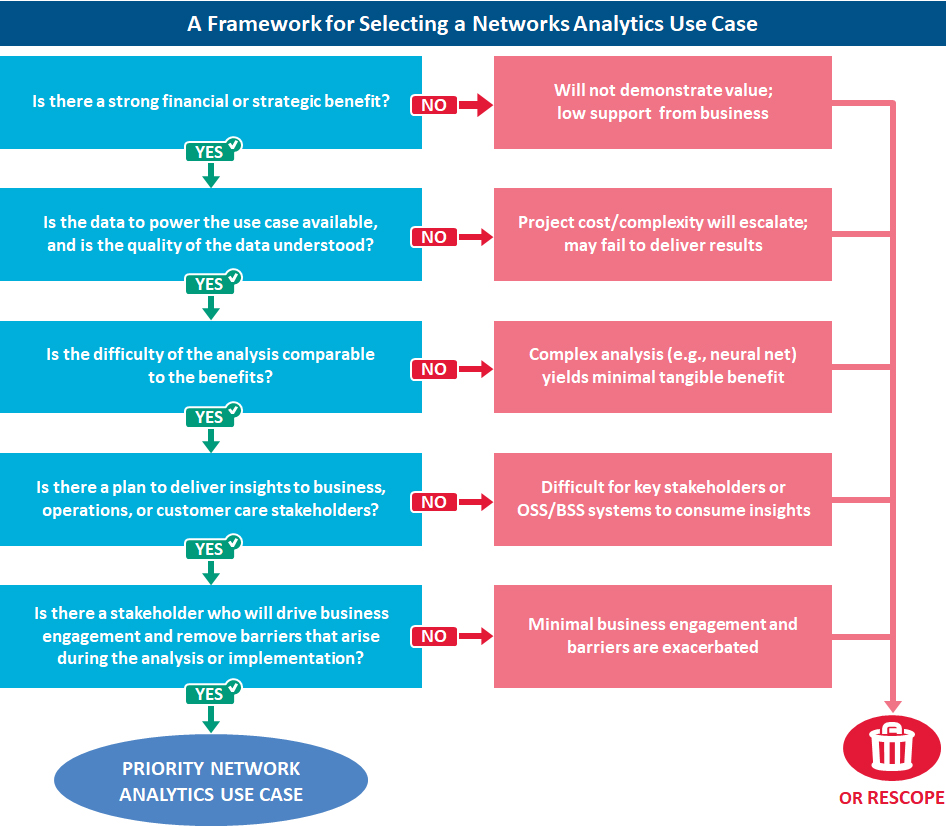How telecom companies can select network analytics use cases
Network Analytics: Part 2
By Nikos Andrikogiannopoulos and Christopher Fergus
In Part 1 of our network analytics series, we discussed how companies can use network data and artificial intelligence (AI) to significantly reduce operational costs and improve customer experience. Before realizing the value of network analytics, telecom companies need to establish a rigorous process to identify and prioritize business use cases. Part 2 of our series outlines the framework we use to maximize the value of advanced analytics use cases for our clients.
A framework for selecting network analytics use cases
Network analytics use cases should not be developed in isolation. Stakeholders from different parts of the business (e.g., operations, engineering, IT, customer care, project management) must be consulted to ensure a use case has the following attributes:
![]() Incremental Business Value: Resources should be allocated towards use cases that create a tangible cost reduction opportunity (e.g., fewer truck rolls) or new revenue stream (e.g., upselling internet speeds to customers with heavy usage). If there isn’t a financial benefit, the soft, or strategic benefits (e.g., enabling additional use cases) must be clearly articulated.
Incremental Business Value: Resources should be allocated towards use cases that create a tangible cost reduction opportunity (e.g., fewer truck rolls) or new revenue stream (e.g., upselling internet speeds to customers with heavy usage). If there isn’t a financial benefit, the soft, or strategic benefits (e.g., enabling additional use cases) must be clearly articulated.
![]() Accessible Data: Use cases with readily available data provide a much clearer path to execution – identifying and obtaining access to data sources, in addition to understanding the state and the quality of data can remove barriers to the analysis.
Accessible Data: Use cases with readily available data provide a much clearer path to execution – identifying and obtaining access to data sources, in addition to understanding the state and the quality of data can remove barriers to the analysis.
![]() Proportionate Complexity: Statistical modeling approaches (e.g. decision trees, random forests, neural networks, etc.) need to be evaluated against the business problem, so there is a match between the complexity of the analysis and a use case’s projected benefits.
Proportionate Complexity: Statistical modeling approaches (e.g. decision trees, random forests, neural networks, etc.) need to be evaluated against the business problem, so there is a match between the complexity of the analysis and a use case’s projected benefits.
![]() Path to Implementation: The feasibility of operationalizing a use case to deliver the insights to business stakeholders, operations, and customer care through supporting OSS/BSS tools must be considered. This may involve re-creating the analysis in a new development environment and transferring the insights to new, production-ready analytics tools.
Path to Implementation: The feasibility of operationalizing a use case to deliver the insights to business stakeholders, operations, and customer care through supporting OSS/BSS tools must be considered. This may involve re-creating the analysis in a new development environment and transferring the insights to new, production-ready analytics tools.
![]() Strong Business Stakeholder: A use case should have business stakeholders to serve as “analytics champions” who see the ultimate value of the proposition. An engaged analytics champion can remove barriers to an analysis or implementing a use case, such as identifying subject matter experts. Analytics Champions provide a deep understanding of business needs, data sources, and systems – they are critical to maintaining a high level of engagement from the business, operationalizing the use case, and realizing projected benefits.
Strong Business Stakeholder: A use case should have business stakeholders to serve as “analytics champions” who see the ultimate value of the proposition. An engaged analytics champion can remove barriers to an analysis or implementing a use case, such as identifying subject matter experts. Analytics Champions provide a deep understanding of business needs, data sources, and systems – they are critical to maintaining a high level of engagement from the business, operationalizing the use case, and realizing projected benefits.
When choosing possible network analytics use cases, here are key questions that a business should ask to decide which use cases to prioritize and which ones should be rescoped or discarded:

Conclusion
In our work, our clients find that following the framework results in efficient allocation of resources to use cases with the greatest value, ease of execution, and internal support. By creating a standardized process to prioritize and select analytics use cases, telecom companies can continuously identify and capitalize on opportunities to leverage network data to improve customer care, reduce operational costs, and expand profits.<>
> To discuss network analytics for your business, click here to contact our team.




